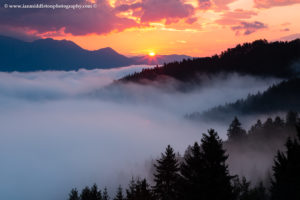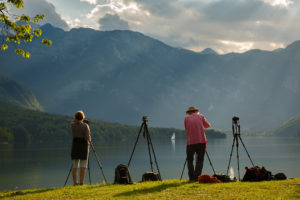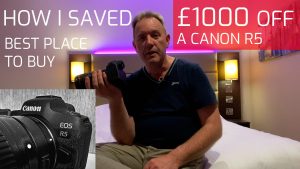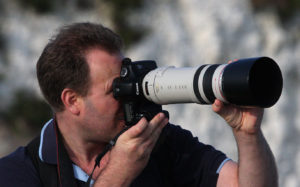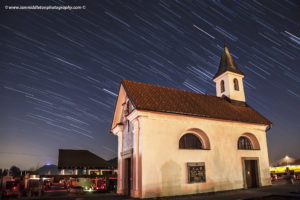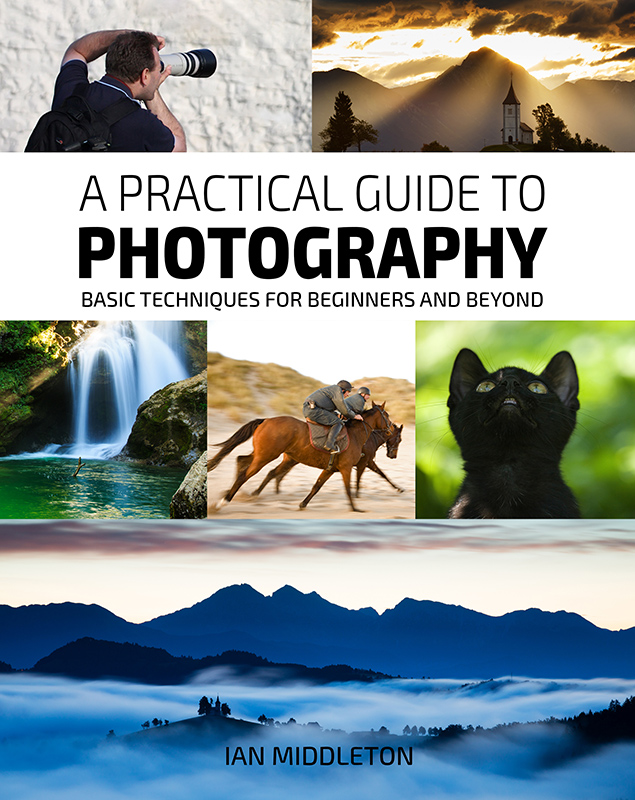Photographing the moon at sunset or sunrise
While any time is great for photographing the moon, the best time to photograph the moon is either at sunset or sunrise. There are two reasons for this: first you get the glorious golden hour colour, plus the intensity of the moon is diffused by the brighter ambient light in the sky. This allows you to also capture landscape features within your image. Another benefit is when captured at the right time, you can do so in one frame rather than having to mess about with double exposures and exposure blending.
Photographing the full moon at sunset or sunrise
At sunset you will capture the full moon rising, while at sunrise you will capture it setting. Now the reason for this is as follows:
The moon is full when the sun is lighting it completely from the front, therefore it has to be opposing the moon. So in order to capture it right at the point the sun rises in the east, the moon needs to be setting in the west (directly opposite). Conversely, to capture it when the sun sets in the west, the moon needs to be rising in the east.
Another thing to consider is the time of year. In summer when the sun sets or rises more to the north, the full moon will rise or set more to the south. In winter it’s the opposite: the sun rises and sets more to the south, therefore the full moon rises and sets more to the north.
Calculating when and where the moon will be
Now of course it’s not always that simple. There are geographical features to contend with, such as mountains and buildings. Therefore you need to take that into consideration as you plan when and where to capture this moment.
Thankfully there are a number of great apps that can help.
Photographing the full moon over Jamnik Church
Jamnik Church
This little church lies in the village of Jamnik. It is well known and loved among photographers and photography workshop leaders. As you can see by the photo here, it’s a stunning photography location, and only about a 45-minute drive from the capital Ljubljana and about the same from Lake Bled. Both are great places to stay.
This little church sits on the edge of the Jelovica Plateau, but from this viewpoint you get the prominent peak of Mt Storzic, 2,132 metres (6,995 feet). While not the highest in the Kamnik Alps, it is surely one of the most beautiful with its distinct conical shape. It makes the perfect backdrop to this scene.
Every year in winter, the moon rises right over this peak. It usually happens around December or January. Here I captured it a little later when it rose at dusk. But, it also rises over the peak right at the point of sunset, if you catch it at the right time.
Best weather conditions
When photographing the moon obviously we need clear skies so the moon is visible. However, when including a landscape feature and capturing it with the golden hour colours we also want some cloud. In the past I’ve tried to shoot scenes like this only to have too much cloud. Often I’ve also had no cloud at all (which is preferable, of course), but here on this occasion it couldn’t have been more perfect. Some lovely wisps of cloud drifting over the mountain peak added some texture to what would have otherwise been a bland sky.
Problems
I shot these photo in January. Sadly, I wasn’t able to get there in December when the moon would rise over the peak exactly at the point of sunset. Here it rose a little too early and by the point of sunset it was a bit higher above the mountain peak. Still a great moment though.
This is the moment the moon rose over the mountains. While the low sun was lighting the mountains with some lovely warm colour, and the clouds were beginning to catch some colour, the problem here was the big nasty shadow creeping up the mountainside.
The magic moment
Here at the point of sunset you can see how the magic came together. Although the moon was a little higher, I managed to manoeuvre myself into a position among the other photographers to align the moon close to the peak.
By this time the shadow had crept further up the mountainside and the sun was lighting just the peak of Storzic, which was much more aesthetically pleasing.
Now the moon, mountain and church were all in alignment it called for a vertical composition.
Equipment and settings
I shoot with a Canon EOS 5D m3. But what is more important here is the lens.
In order to get this perspective you need to shoot from further away and use a telephoto lens. Here I used a Canon EF 100-400mm f/4.5-5.6L IS USM lens. This lens offers superb quality which is very important when zooming in close to distant locations.
Settings:
- Focal Length – 180mm
- Shutter speed – 0.5 sec
- Aperture – F16
- ISO 400
Dynamic range and filters
Another reason why photographing the moon at the golden hour is best, is because you don’t have to deal with extremes of light. When you photograph the moon at night or the twilight of late dusk or early dawn, the difference in brightness between the moon and land is huge. Even the highest end cameras with the best dynamic range would struggle to capture it all in one frame.
The balance between the two is much better during the golden hour. As the sky is still quite bright, the intensity of the moon is diffused quite a bit. In the photos above, I used a 3-stop soft grad filter with a Kase K9 filter holder to help balance the foreground and sky, but all the images were captured in one frame.
I also used a Kase magnetic polariser to help cut through any haze, although because it was winter the weather was crisp and clear, so the haze was minimal. However, when zooming in to a distant scene, haze can often be a problem.
The detail of the moon was not lost, and I was also able to pull back some extra detail using the highlights tool in Adobe Photoshop.
The first photo, taken at dusk a few years before, was done using a double exposure. Here it was not possible to capture in one shot, so I took one exposure for the moon and one for the rest of the scene. By blending the two exposures I was able to preserve the details in the moon, whereas in the brighter exposure they were lost.
Full Moon at Saint Thomas Church
This great photography location is the fabulous view of Saint Thomas Church with the Kamnik Alps behind. It is not too far from Jamnik and also about a 45-minute drive from Ljubljana. For the vast majority of the time this is a sunrise location, but on this occasion I had to go once again at sunset.
It was the same time of year too. While I was photographing this, others were photographing it from Jamnik. Just like with Jamnik, it’s a once-a-year event. However, of course you have to choose between the two, because they both happen at the same time, obviously.
A difficult choice
As I still haven’t been able to figure out how to be in two places at once, I had to choose between the two. Now I knew that many other photographers would be at Jamnik (as they were this year) but I suspected there would be less here.
Although this is another well-known location for photographers and workshops, I had never seen a single photo of the moon rising here. Again I used TPE to confirm where and when the moon would rise, and headed out that afternoon with a promise from the weatherman of clear skies.
My gamble paid off. There was only one other photographer, and he was just getting some timelapse photos for his superb timelapse videos.
I was extremely happy here as I believe I have the most unique photo of this well-photographed location.
Single shot
Once again, these photos were both captured in a single frame. This time with a 3-stop hard grad. As twilight approaches a grad will help a lot. The darker the sky the more intense the moon appears, but there is a point at which it becomes too much to handle even with a grad.
- Focal length – 100mm
- Shutter speed – 0.6 sec
- Aperture – F11
- ISO 400
Videos
How I photographed it
How I processed the photos
Which white balance settings?
For the images of Jamnik and Saint Thomas I set a cloudy white balance. Not only does this help enhance the warmth of the golden hour, but it also adds some nice warmth to the moon itself.
Full Moon rising over Ljubljana Castle
I used Photopills to plan this shot. The advantage to Photopills over TPE is that you can have an idea, plot it on their app and do a search for up to five years to see when the event may occur. The app gives you all the results with dates and times, phases of the moon and whether during day, night twilight or golden hour.
This thought came to me after learning about the viewpoint from the great website, Photohound. I had scouted and photographed the location a few times. On Photopills, I plotted in my idea and was surprised to find that it was going to happen that year.
Summer shot
This is the exact opposite of the Jamnik and Saint Thomas photos. The view here is looking southeast. Therefore, as the full moon is rising in the southeast, the sun needs to be setting in the northwest; as explained earlier the sun needs to be directly opposite. So this moment can only happen in the summer, around July.
- Focal Length – 330mm
- Shutter speed – 0.3 sec
- Aperture – F11
- ISO 400
Two more photos from Slovenia taken around sunrise this time.
- Focal Length – 320mm
- Shutter speed – 1 sec
- F40
- ISO 200
- No filters
- Focal Length – 400mm
- Shutter speed – 2.5 sec
- F32
- ISO 50
- No filters
Durdle Door at Dusk
This one caught me by surprise. I had gone to Durdle Door just to photograph the sun go down behind the cliffs. It was July, high summer, and it was also completely clear. Once the sun had set, I went for a walk along the beach for a bit with the intention of heading back home after.
When I turned to walk back, I was surprised to see the moon coming up. Ok the moon wasn’t full, but it was early enough to still capture it rising over the arch.
As it got darker of course it became more difficult to retain the detail. So instead I stopped trying and went for something different.
Now event at late dusk there is still some ambient light in the sky and the moon itself also helps light the foreground. But you still need to expose well enough to capture it, and thus there will be no detail unless you do a double exposure, like the one at the top.
So, you need to get creative.
Moon over the arch
I managed to place myself into just the right position to get the moon inside a dip in the arch. By using a long exposure and small aperture I was able to create a starburst effect. I used the fluorescent white balance here to maintain the blue tones of twilight and the white of the moon.
- Focal Length – 32mm
- Shutter speed – 363 sec
- F16
- ISO 400
- Fluorescent white balance
SuperMoon over Lake Bled
It was almost midnight when I shot this image at the beautiful Lake Bled, so well past twilight. However, as it was so clear and the supermoon so bright it was still possible in one shot, but of course there was no chance of capturing any detail.
Instead, I opted for a wide angle and long exposure to create the starburst effect. The moonlight reflecting on the wooden jetty helped really bring this image to life.
I was so mesmerized by this scene that I almost stepped on a courting couple on the jetty.
- Focal Length – 24mm
- Shutter speed – 25 sec
- F10
- ISO 640
- Fluorescent white balance

Crescent moon
The moon doesn’t always have to be full. The crescent moon at dawn here added a nice extra little touch to this scene.
- Focal Length – 60mm
- Shutter speed – 20 sec
- F16
- ISO 400
- No filters
Best time to photograph the moon
So, as you can see, the best time to photograph the moon is during the golden hour or early twilight if you want the detail without having to resort to double exposures. However, when it comes to moon photography you don’t always need the detail to create a great moonshot.
Equipment used in my photoshoots
These are links to photography equipment I use and what’s in my bag and great places to buy them.
These are affiliate links so if you click and purchase I’ll receive a small commission in return, but at no extra cost to you.















